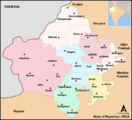Social:Bagri language
| Bagri | |
|---|---|
| बागड़ी, باگری | |
 The word "Bagri" written in Devanagari script | |
| Native to | |
| Region | Bagar |
| Ethnicity | Bagri |
Native speakers | 1,890,815 (2011 census)[1] |
Indo-European
| |
| Devanagari, Arabic script | |
| Language codes | |
| ISO 639-3 | bgq |
| Glottolog | bagr1243[2] |
The Bagri (बागड़ी / باگڑی) is a language that forms a dialect bridge between Haryanvi, Rajasthani, and Punjabi and takes its name from the Bagar tract region of Northwestern India.[3] The speakers are mostly in India , in the Sangaria,Rawatsar,Pilibanga,Nohar-Bhadra,Anupgarh, Hanumagarh , Northern tehsils of Bikaner and Sri Ganganagar district of Rajasthan , Sirsa and Fatehabad district Hisar,Bhiwani,Charkhi dadri district of Haryana, Fazilka district of Punjab in India .
Bagri is a typical Indo-Aryan language akin to Haryanvi, Punjabi and Rajasthani with SOV word order. The most striking phonological feature of Bagri is the presence of three lexical tones: high, mid, and low, akin to Punjabi.[4] The language has a very high (65%) lexical similarity with Haryanvi. According to the 2011 Census, there are 234,227 speakers of Bagri Rajasthani and 1,656,588 speakers of Punjabi Bagri.[5]
Features
Phonology
Bagri distinguishes 31 consonants including a retroflex series, 10 vowels, 2 diphthongs, and 3 tones.
/ɳ/, /ɭ/ and /ɽ/ do not occur word initially.
| Front | Central | Back | |
|---|---|---|---|
| Close | iː ⟨ī⟩ | uː ⟨ū⟩ | |
| Near-close | ɪ ⟨i⟩ | ʊ ⟨u⟩ | |
| Close-mid | eː ⟨e⟩ | ə ⟨a⟩ | oː ⟨o⟩ |
| Open-mid | ɛː ⟨ai⟩ | ɔː ⟨au⟩ | |
| Open | aː ⟨ā⟩ |
All vowels have their nasalised counterpart, marked with ◌̃ (ँ in Devanagari).
Bagri has 3 tones in a similar way to the Punjabi language. A rising-falling tone ◌́, a rising tone ◌̀, and an unmarked mid tone.[6]
Declension
- There are two numbers: singular and plural.
- Two genders: masculine and feminine.
- Three cases: simple, oblique, and vocative. Case marking is partly inflectional and partly postpositional.
- Nouns are declined according to their final segments.
- All pronouns are inflected for number and case but gender is distinguished only in the third person singular pronouns.
- The third person pronouns are distinguished on the proximity/remoteness dimension in each gender.
- Adjectives are of two types: either ending in /-o/ or not.
- Cardinal numbers up to ten are inflected.
- Both present and past participles function as adjectives.
Verbs
- There are three tenses and four moods.
Syntax
- Sentence types are of traditional nature.[clarification needed]
- Coordination and subordination are very important in complex sentences.
- Parallel lexicon are existing and are very important from sociolinguistic point of view.[clarification needed]
Samples
This section does not cite any external source. HandWiki requires at least one external source. See citing external sources. (April 2023) (Learn how and when to remove this template message) |
Official status
There are two varieties of Bagri, Bagri Rajasthani and Bagri Punjabi. During the census, Bagri Rajasthani, spoken in Haryana and Rajasthan, is considered a Hindi dialect while Bagri Punjabi, spoken in Punjab, is considered a Punjabi dialect.[5]
Work on Bagri
- Grierson, G. A. 1908. (Reprint 1968). Linguistic Survey of India. Volume IX, Part II. New Delhi: Motilal Banarasidass
- Gusain, Lakhan. 1994. Reflexives in Bagri. M.Phil. dissertation. New Delhi: Jawaharlal Nehru University
- Gusain, Lakhan. 1999. A Descriptive Grammar of Bagri. Ph.D. dissertation. New Delhi: Jawaharlal Nehru University
- Gusain, Lakhan. 2000a. Limitations of Literacy in Bagri. Nicholas Ostler & Blair Rudes (eds.). Endangered Languages and Literacy. Proceedings of the Fourth FEL Conference. University of North Carolina, Charlotte, 21–24 September 2000
- Gusain, Lakhan. 2000b. Bagri Grammar. Munich: Lincom Europa (Languages of the World/Materials, 384)
- Gusain, Lakhan. 2008. Bagri Learners' Reference Grammar. Ann Arbor, Michigan: Northside Publishers
- Wilson, J. 1883. Sirsa Settlement Report. Chandigarh: Government Press
Gallery
Regions where Bagri is spoken:
See also
- Rajasthani language
- List of winners of Sahitya Akademi Awards for writing in Rajasthani language
- List of Rajasthani poets
- List of Indian poets#Rajasthani
References
- ↑ "Statement 1: Abstract of speakers' strength of languages and mother tongues - 2011". Office of the Registrar General & Census Commissioner, India. http://www.censusindia.gov.in/2011Census/Language_MTs.html.
- ↑ Hammarström, Harald; Forkel, Robert; Haspelmath, Martin, eds (2017). "Bagri". Glottolog 3.0. Jena, Germany: Max Planck Institute for the Science of Human History. http://glottolog.org/resource/languoid/id/bagr1243.
- ↑ "Revised Land and Revenue Settlement of Hisar District 9006-9011". http://revenueharyana.gov.in/html/gazeteers/revised_settlement_hisar.pdf.
- ↑ Gusain 2000, p. 14.
- ↑ Jump up to: 5.0 5.1 "LANGUAGE - INDIA, STATES AND UNION TERRITORIES (Table C-16)". https://censusindia.gov.in/2011Census/C-16_25062018_NEW.pdf.
- ↑ Jump up to: 6.0 6.1 6.2 Gusain, Lakhan. A Descriptive Grammar of Bagri. pp. 165 - 198.
Bibliography
- Gusain, Lakhan (1999). A Descriptive Grammar of Bagri (PhD). Jawaharlal Nehru University. hdl:10603/16847.
- Gusain, Lakhan (2000). Bagri. Languages of the world. Materials. Munich: LINCOM Europa. ISBN 978-3-89586-398-1.
External links
 |





